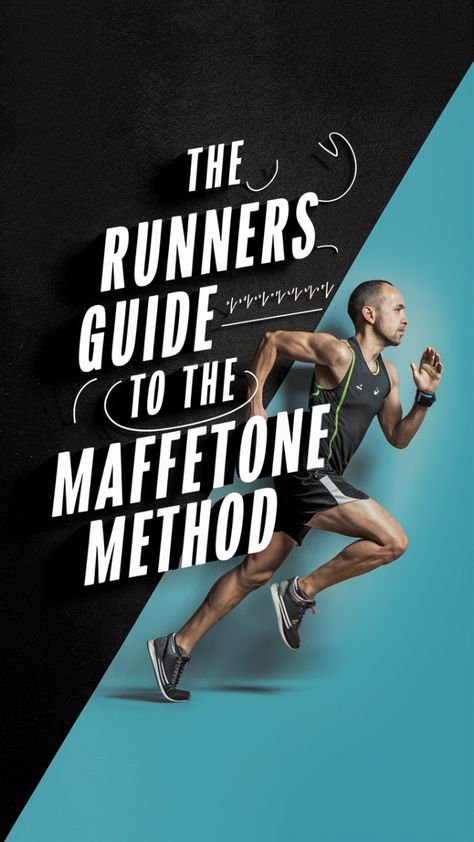Today, I want to share a training method that completely changed how I approach running: the Maffetone Method.
This isn’t about sprinting to the finish or pushing max speed on every run. Instead, this approach is all about slowing down—way down—to build a foundation that will eventually make you faster, stronger, and more efficient.
I’ll be honest—it felt odd starting with the MAF Method. I first thought, ‘How on earth does slowing down make me faster?
But after coaching and using it myself for years, I can confidently say it works wonders for building long-term endurance.
Stick with it, and I’m sure you’ll start seeing results as well.
Keep on reading to learn more about this amazing method.
The Maffetone Method Explained
Also called the MAF Method, this technique keeps your heart rate right in the aerobic sweet spot while you run. This involves working out mostly or entirely in the so-called aerobic or fat-burning zone—zone 2.
To find your max aerobic heart rate, start with 180 minus your age and tweak it according to your fitness, health, and past injuries. (we’ll get into that in a bit). In my case, zone 2 is around 143 beats per minute. This means I must log most of my miles under 143 bpm to increase my cardio and fat-burning efficiency at the same heart rate.
Dr. Phil Maffetone developed this method, a trailblazer in sports medicine who’s optimized performance for countless athletes from runners to triathletes
The idea behind the MAF Method is simple: train your body to run faster at a lower heart rate. It boosts your aerobic base, delays the switch to your anaerobic system, and lets you run longer distances with ease..
This method also improves the percentage of calories burned from fat while working out.
What’s not to like, really!
Don’t take my word for it. Maffetone says on his website: “Some people rely on larger amounts of fat, with the result of high physical and mental vigor, improved health, and better all-around performance.”
What Heart Rate Should You Train At?
You need to figure out your maximum aerobic heart rate to follow this method. This is where the 180 Formula comes in. It’s super simple:
- Start with 180 and subtract your age.
- Then, make adjustments based on your current health and fitness level:
- If you’re recovering from a major illness or surgery, subtract another 10.
- If you’ve been injured or have health issues, subtract 5 to 10.
- If you’re new to exercise or have been inconsistent, subtract 5.
- If you’ve been training consistently for a couple of years without injury, use the basic formula (180 – age).
- If you’ve been competing for years and have no health issues, you can add 5.
For example, if you’re 40 and have been training regularly, your max aerobic heart rate would be 180 – 40 = 140 bpm. That’s the upper limit you want to stay below during your runs.
At first, logging miles at such a low heart rate feels super slow, but stick with it—it gets better.
Is the MAF Method Right for You?
The Maffetone Method isn’t for everyone, but if your goals include any of the following, it might be a great fit for you:
- Building a solid aerobic base for endurance running
- Improving fat-burning efficiency during training
- Learning to pace by effort without constantly checking your watch
- Reducing injury risk and improving recovery
- Managing chronic fatigue or overtraining symptoms
What You Gain from MAF Training
I’ve seen firsthand how the Maffetone Method can transform a runner’s performance. Whether you’re a beginner or an experienced runner, this method helps you focus on what truly matters in endurance sports—your aerobic fitness.
When I coach beginner runners or those getting into the sport later in life, I always emphasize the importance of building an aerobic base before diving into harder training.
Let’s dive into some of the perks.
- Improved Fat Burning
One of the main perks of the method is how it teaches your body to become a fat-burning machine. When you run long distances, your body uses a mix of glycogen (carbs) and fat for fuel.
But here’s the catch—your glycogen stores only last about two hours, max. Beyond that, your body starts burning more fat for fuel.. Training in your aerobic zone teaches your body to tap into those fat reserves earlier and more efficiently.
- Builds a Strong Aerobic Base
I always tell my runners that the foundation of any solid running program is a strong aerobic base. The Maffetone’s heart-rate training method is all about that. It helps you run longer distances at a lower heart rate, which improves your endurance and efficiency. This is key if you’re in it for the long haul (and aren’t we all?).
- Reduces Dependency on Technology
Another plus is learning to trust your body’s signals over your GPS watch.. You learn to pace yourself based on effort rather than obsessing over speed. It’s a great way to build a more intuitive sense of running.
- Better Recovery
Staying in the aerobic zone means less strain on your body. This means faster recovery times between runs and fewer injuries. Trust me, I’ve seen it firsthand—my athletes (and myself!) bounce back quicker from long runs when they stick to their set heart rate.
The Downsides of MAF Training
While the MAF Method has helped me in many ways, it’s not without its challenges. Here are a few snags I’ve hit, which you might too if you try it out..
- Slow Can Feel Boring
What I dislike the most about the method is that it’s extremely tedious, especially during the initial stages.
Running at a slower pace can feel like you’re going nowhere fast. To stay under your maximum aerobic heart rate, you might jog really slow or even walk during parts of your run.
When I started using this method, I had to swallow my pride and accept that slowing down now would pay off later. But it’s an adjustment.
- It’s Not a Magic Bullet for Injuries
Some people say that training in your aerobic zone will magically prevent all injuries, but that’s not entirely true. While it reduces the risk of overtraining injuries, you can still get hurt if you’re not careful with your form, shoes, and overall mileage. Slowing down helps, but it’s not a cure-all.
- Inflammation Isn’t Always Bad
Maffetone’s heart-rate training method focuses on reducing inflammation, but here’s something to consider: not all inflammation is bad. After all, it’s part of how your body adapts and gets stronger. You don’t want to be constantly inflamed, but you also don’t want to avoid every bit of stress—otherwise, you’ll never improve.
The MAF Test
One of the cool things about Maffetone’s heart-rate training approach is the MAF Test—a simple way to measure your progress over time.
Here’s how you do it:
- Warm up for 10 to 15 minutes, staying about ten bpm below your maximum aerobic heart rate.
- Choose a flat course (preferably a track) and run five miles (or three, if you’re newer) at your target heart rate.
- Record your time for each mile. Each mile should get slower as your heart rate rises throughout the test.
- Perform this test once a month under similar conditions to track your improvement.
Over time, as you get fitter, your pace at the same heart rate should get faster. If your times aren’t improving, it could be a sign that you’re overtraining or on the verge of injury.

Share Your Maffetone Method Journey!
Have you tried the Maffetone Method? We’d love to hear about your experience! Whether you’re just starting out or have been training at a low heart rate for a while, your insights can make a real difference for other runners on this journey.
Share your thoughts, challenges, and any advice you have for others in the comments below. Let’s create a supportive space where we can learn from each other’s successes and tackle the tough spots together!



Thank you for this article! I was getting frustrated with my progress, but the Maffetone Method has helped me focus on the long-term gains. It’s tough to be patient, but I’m already feeling more energized during my runs.
I tried this method for a few weeks, and while I see the value, I found it difficult to stick with. I like pushing myself and felt like I was missing out on the intensity of my regular workouts. Might not be the best fit for my running style.
This method seems like a great approach for long-term health and endurance, but it feels too slow for someone like me who enjoys speedwork. I think a balance between Maffetone and high-intensity intervals might be more effective.
This is a great introduction to the Maffetone Method! I’ve been considering adding heart rate training to my routine, and this article gave me a clear understanding of how to get started. I’m excited to see if it helps my performance.
I gave the Maffetone Method a shot, but it felt too slow for my liking. I enjoy the intensity of interval and tempo training. I can see how it works for others, but I think it’s not for everyone.
I’m intrigued by the Maffetone Method, but I’m not sure I have the patience to run that slow consistently. It seems like it would take forever to see real results, and I enjoy pushing myself more in my workouts.
Great insights on the Maffetone Method! I’ve been following it for the past year, and my endurance has improved without the constant injuries I used to experience from pushing too hard. Highly recommend for anyone who struggles with overtraining.
I’ve been using the Maffetone Method for a year now, and it’s made a huge difference in my running. I used to get injured a lot, but now I can run longer and recover faster. This article does a great job of explaining the benefits
Wow, this really opened my eyes to a new way of training! I’m used to pushing myself hard, but slowing down to build my aerobic base seems like the missing piece in my training. Thanks for breaking it down so clearly.